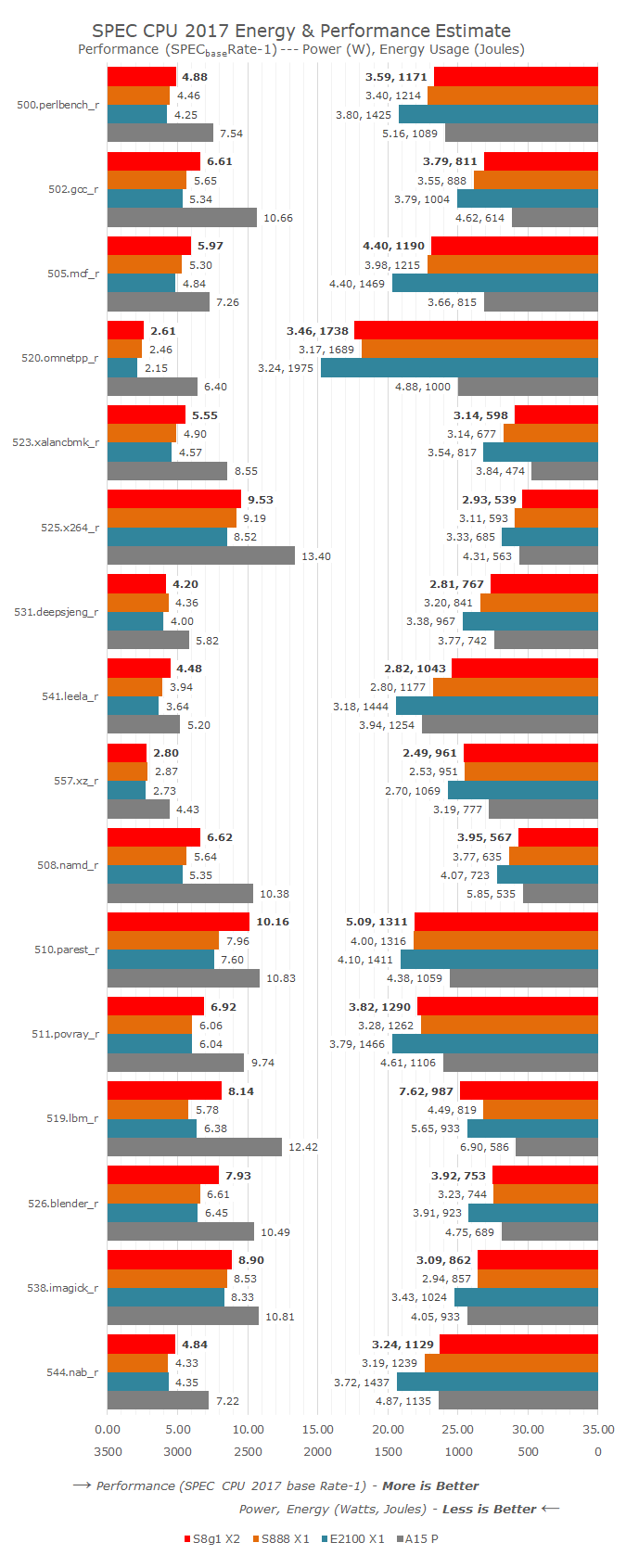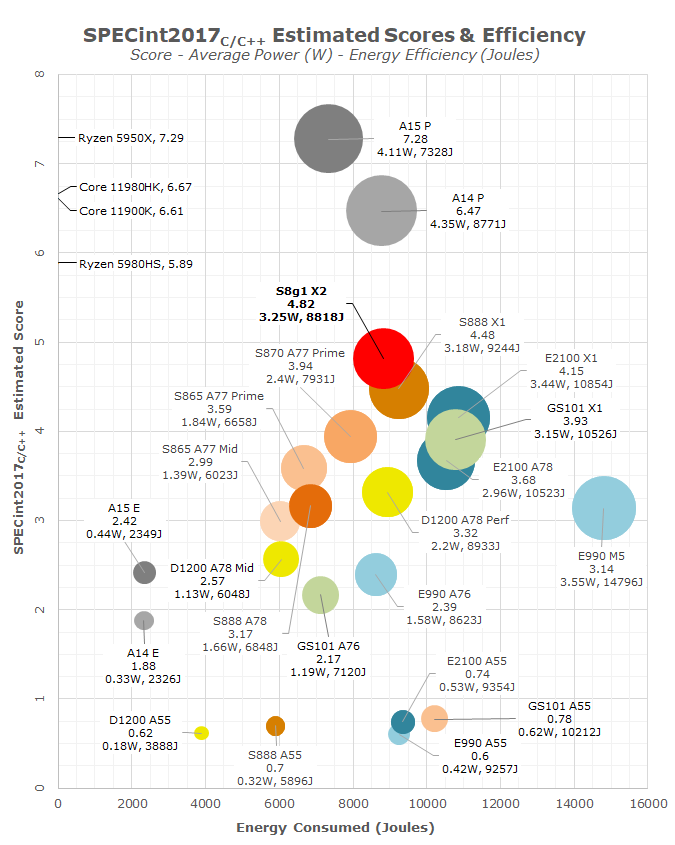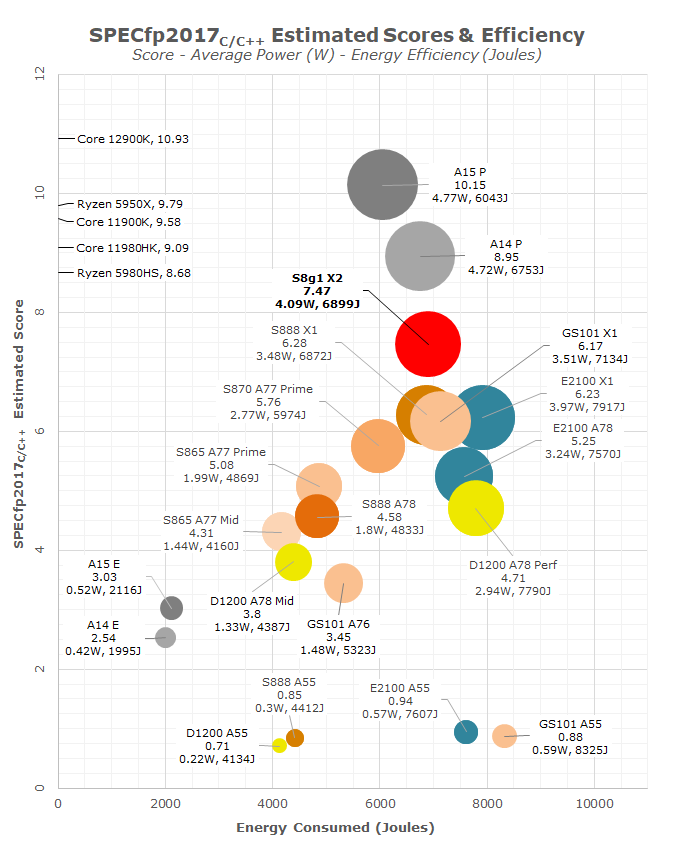The Snapdragon 8 Gen 1 Performance Preview: Sizing Up Cortex-X2
by Dr. Ian Cutress on December 14, 2021 8:00 AM ESTTesting the Cortex-X2: A New Android Flagship Core
Improving on the Cortex-X1 by switching to the Arm v9 architecture and increasing the core resources, both Arm and Qualcomm are keen to promote that the Cortex-X2 offers better performance and responsiveness than previous CPU cores. The small frequency bump from 2.85 GHz to 3.00 GHz will add some of that performance, however the question is always if the new manufacturing process coupled with the frequency increase allows for better power efficiency when running these workloads. Our standard analysis tool here is SPEC2017.
Running through some of these numbers, there are healthy gains to the core, and almost everything has a performance lift.
On the integer side (from 500.perlbench to 557.xr), there are good gains for gcc (+17%), mcf (+13%), xalancbmk (+13%), and leela (+14%), leading to an overall +8% improvement. Most of these integer tests involve cache movement and throughput, and usually gains in sub-tests like gcc can help a wide range of regular user workloads.
Looking at power and energy for the integer benchmarks, we’re seeing the X2 consume more instantaneous power on almost all the tests, but the efficiency is kicking in. That overall 8% performance gain is taking 5% less total energy, but on average requires 2% more peak power.
If we put this core up against all the other performance cores we test, we see that 8% jump in performance for 5% less energy used, and the X2 stands well above the X1 cores of the previous generation, especially those in non-Snapdragon processors. There is still a fundamental step needed to reach the Apple cores, even the previous-generation A14 performance core, which scores 34% higher for the same energy consumed (albeit on average another 34% peak power).
Just on these numbers, Qualcomm’s +20% performance or +30% efficiency doesn’t bare fruit, but the floating point numbers are significantly different.
Several benchmarks in 2017fp are substantially higher on the X2 this generation. +17% on namd for example would point to execution performance increases, but +28% in parest, +41% in lbm and +20% in blender showcases a mix of execution performance and memory performance. Overall we’re seeing +19% performance, which is nearer Qualcomm’s 20% mark. Note that this comes with an almost identical amount of energy consumed relative to the X1 core in the S888, with a difference of just 0.2%.
The major difference however is the average power consumed. For example, our biggest single test gain in 519.lbm is +41%, but where the S888 averages 4.49 watts, the new X2 core averages 7.62 watts. That’s a 70% increase in instantaneous power consumer, and realistically no single core in a modern smartphone should draw that much power. The reason why the power goes this high is because lbm leverages the memory subsystem, especially that 6 MiB L3 cache and relies on the 4 MiB system level cache, all of which consumes power. Overall in the lbm test, the +41% performance costs +20% energy, so efficiency is still +16% in this test. Some of the other tests, such as parest and blender, also follow this pattern.
Comparing against the competition, the X2 core does make a better generation jump when it comes to floating point performance. It will be interesting to see how other processors enable the X2 core, especially MTK’s flagship at slightly higher frequency, on TSMC N4, but also if it has access to a full 14 MiB combination of caches as we suspect, that could bring the power draw during single core use a lot higher. It will be difficult to tease out exactly who wins what where based on implementation vs. process node, but it will be a fun comparison to make when we look purely at the X2 vs. X2 cores.
Unfortunately due to how long SPEC takes to run (1h30 on the X2), we were unable to test on the A710/A510. We’ll have to wait to see when we get a retail unit.













169 Comments
View All Comments
naagin - Thursday, February 10, 2022 - link
naagin 6 Today EpisodeWatch naagin 6 Today Live Full Episode, naagin 6 Latest Full Episode Streaming on Mx Player, Hindi Drama naagin All Episode Season 6 Youtube, Tv Drama naagin 6 Today Full Episode Watch Online In High Qualiy Video Youtube Dailymotion, naagin 6 Today Episode Promo, Get all the information about naagin 6 Tv Series
<a href="https://naaginlive.com/"> naagin 6 Today Episode</a>
back2future - Wednesday, December 15, 2021 - link
Thank you and best wishesskavi - Tuesday, December 14, 2021 - link
Also is there anywhere I could read up on the characteristics of each of the MLPerf benchmarks?ChrisGX - Wednesday, December 15, 2021 - link
These might help:https://towardsdatascience.com/demystifying-mlperf...
https://www.computer.org/csdl/magazine/mi/2021/03/...
https://sites.google.com/g.harvard.edu/mlperf-benc...
https://mlcommons.org/en/
lemurbutton - Tuesday, December 14, 2021 - link
Boring. Until Qualcomm can do something custom, instead of just using stock ARM cores, it's not interesting.As usual, it's far slower than iPhones. People are getting ripped off when they buy slower Android hardware instead of iPhones.
cknobman - Tuesday, December 14, 2021 - link
There are plenty of other, more important, drawbacks to buying (renting) and iPhone.True the processer performance is not as fast as Apple but I'm on a S865 and have yet to find a situation where it was "slow" or not fast enough.
So in the grand scheme these performance metrics dont mean much other than bragging rights.
I'd rather own a device that I have the freedom to do whatever I want to with than have "benchmark bragging rights" and be told what I'm allowed to do on a device Apple thinks I technically "rent" from them.
Alistair - Tuesday, December 14, 2021 - link
Everything said you said is true about iPhones being locked down. But if the speed doesn't matter, then you can buy a $300 Android Phone. There's no justification for expensive Android phones.t.s - Wednesday, December 15, 2021 - link
Well, I bought Redmi Note 9 Pro with 2 A76 and 6 A55, and still happy with it. Not a speed monster, but for my everyday use, it's sufficient.Meteor2 - Friday, December 17, 2021 - link
Yep Pixel 4a XL here. Never wants for performance, and the software is fantastic.It's interesting to see how far the performance and efficiency of these tiny, low-power processors can be pushed, but it's pretty academic. Nobody uses them for AAA games or compiling.
Kangal - Sunday, December 19, 2021 - link
The Samsung A52-S is the flagship killer.It has a SoC that's faster than the QSD 888+ after it throttles, great battery life, display, and adequate cameras. The 3-year software updates, IP67 waterproofing, nice hardware, and premium features like microSD and Headphone Jack are just icing on the cake. During Black Friday sales, you could snag one direct from Samsung for USD $300 which is a steal. There's a good reason Samsung is trying to phase it out so soon, while they downgrade the successor A53 in the coming months.
Worthy competitors are the Samsung S20-fe and OnePlus 8t, but overall the A52-S is still the winner.